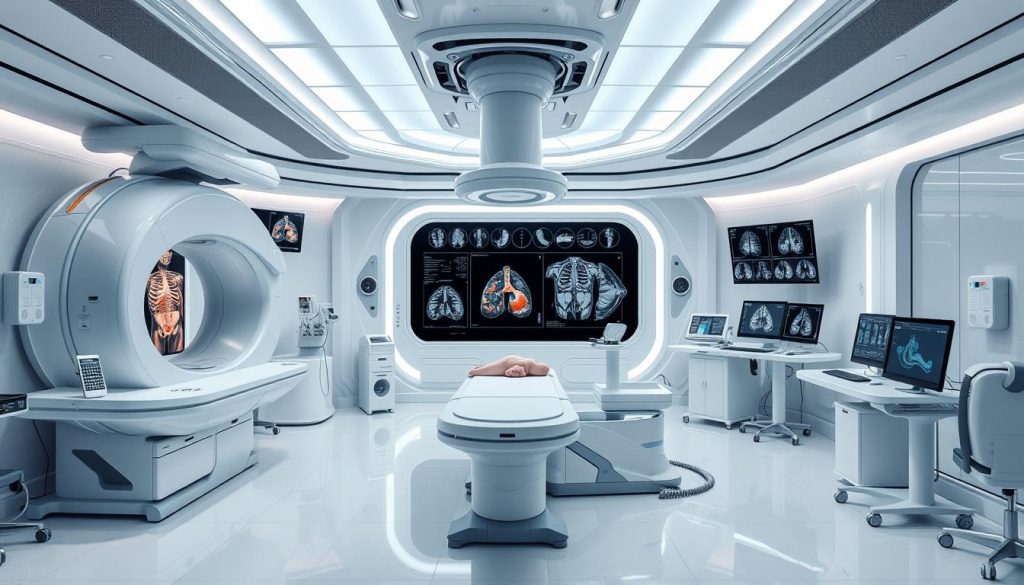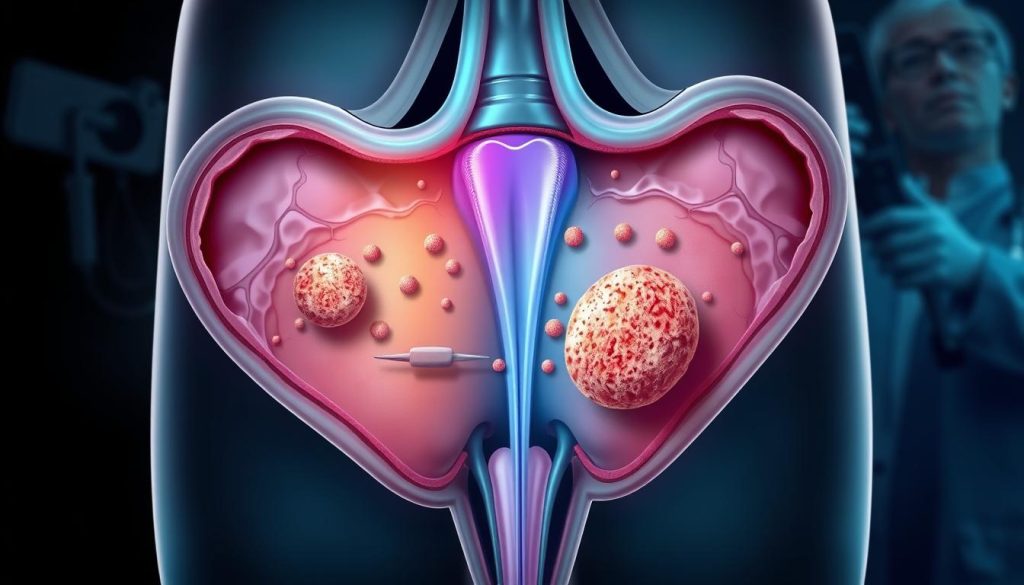Getting a cancer diagnosis can be overwhelming. For those facing anal cancer, knowing how it’s diagnosed is key. Early detection and accurate diagnosis are vital for treatment success. This guide aims to explain the anal cancer diagnosis process in a clear and caring way.
The first step is noticing symptoms and seeing a doctor quickly. Through professional tests and exams, people can find answers and a way forward…
Key Takeaways
- The early detection of anal cancer is crucial for successful treatment outcomes.
- A step-by-step, empathetic understanding of the anal cancer diagnosis process helps alleviate anxiety.
- Maintaining awareness of symptoms leads to timely medical advice and early diagnosis.
- Advanced medical technology and techniques play a key role in identifying anal cancer.
- Accessible medical information empowers patients and their families during challenging times.
Understanding Anal Cancer and Its Symptoms
Anal cancer is not as common as other types, but it’s important to catch it early. This part talks about what anal cancer is, its symptoms, and why you should see a doctor fast.
What Is Anal Cancer?
Anal cancer happens in the anal canal, which is the tube at the end of the rectum. It’s different from colorectal cancers and linked to human papillomavirus (HPV). Knowing when to get anal cancer screening and what diagnostic tests for anal cancer are key for early treatment.
Common Symptoms Associated with Anal Cancer
Spotting symptoms early can help a lot. Common signs of anal cancer include:
- Unexplained rectal bleeding
- Persistent anal itching
- Pain or pressure in the anal area
- A noticeable lump or swelling near the anus
- Changes in bowel habits
These signs can look like other, less serious issues. That’s why diagnostic tests for anal cancer are so important for a right diagnosis.
When Should You Consult a Doctor?
If you notice any of these symptoms, see a doctor. Early anal cancer screening is especially good for those at higher risk. This includes people over 50, those with HPV history, or those with weak immune systems. A doctor will decide if more diagnostic tests for anal cancer are needed.
Knowing these signs and getting anal cancer screening early can help a lot. It’s crucial for managing anal cancer well. Being aware and acting fast can make a big difference for those dealing with this tough diagnosis.
Initial Consultation: The First Step to Diagnosis
The journey to diagnosing anal cancer often starts with an initial consultation. This first step is crucial for understanding and addressing the patient’s concerns. It helps establish a baseline of health before exploring more specific methods of diagnosing anal cancer.
During this meeting, healthcare professionals evaluate symptoms and gather detailed personal and family medical histories.
Detailed discussions focus on any signs the patient has experienced, lifestyle factors, and genetic predispositions. It’s a compassionate environment. Here, patients can express their anxieties about possible outcomes and the anal cancer diagnosis process.
- Review of personal medical history
- Evaluation of symptoms related to anal cancer
- Discussion of family health history
- Assessment of lifestyle factors impacting health
This approach helps identify potential risk factors. It also strengthens the patient-centered care ethos. This emphasizes empathy and understanding from the start.
Physical Examination: Looking for Signs of Anal Cancer
The first steps in finding out if you have anal cancer start with a detailed physical check-up. This check-up is key to spotting signs of anal cancer. Knowing what to expect can help ease your worries before your visit.

What to Expect During a Physical Exam
A healthcare provider will look at the anal area for any unusual signs like lumps or swelling. They will also check the skin around the anus for any lesions or fissures. A digital rectal exam (DRE) might also be done to feel for anything unusual inside the rectum.
Understanding the Digital Rectal Exam (DRE)
The Digital Rectal Exam is a big part of diagnosing anal cancer. It involves the doctor putting a lubricated, gloved finger into the rectum to check for any odd feelings. It might be a bit uncomfortable, but it’s quick and very important for finding cancer early.
For more details on diagnosing anal cancer, check out this reliable source.
Knowing how important regular check-ups are can help catch anal cancer early. Talking openly with your doctor can also help a lot.
How Is Anal Cancer Diagnosed: Diagnostic Testing
Diagnosing anal cancer involves several diagnostic tests for anal cancer. Each test has a specific role in confirming the cancer’s presence and extent. The anal cancer biopsy is a key test in confirming the diagnosis.
Knowing about the different tests helps patients and their families understand what to expect. It also helps them grasp the importance of each step in the diagnostic process.
- Physical Examination: Initial check-ups include visual inspection and palpating areas near the anus for abnormalities or lumps.
- Digital Rectal Exam (DRE): A physician manually examines the inside of the anus and rectum using a gloved, lubricated finger.
- Anoscopy: An anoscope is inserted into the anus to help doctors see any abnormalities.
- Imaging Tests: Procedures like ultrasound, MRI, or CT scans that provide images of the anal and surrounding regions.
- Anal Cancer Biopsy: The procedure involves taking a small sample of tissue from the anal area, which is then examined under a microscope for cancer cells.
Each test provides valuable information. But it’s the biopsy that gives conclusive evidence. Here’s a detailed look at the steps involved in conducting an anal cancer biopsy:
| Step | Description |
|---|---|
| Preparation | The area around the anus is cleaned, and local anesthesia may be used. |
| Procedure | Using a biopsy needle or a small scalpel, a tissue sample is removed. |
| Analysis | The sample is sent to a lab where pathologists examine the tissue for cancer cells. |
| Follow-up | Results are discussed with the patient and potential next steps are planned based on the outcomes. |
While a biopsy might seem daunting, it’s a crucial step in accurately diagnosing anal cancer. An anal cancer biopsy is done with precision and care. It aims to minimize discomfort while providing crucial insights into the patient’s health status.
The variety of diagnostic tests for anal cancer helps detect the disease and plan effective treatments. These tests ensure a comprehensive approach to tackling anal cancer. They help from the initial detection to creating a tailored treatment plan.
Anal Cancer Screening: What Are the Options?
Medical experts now know how important it is to find anal cancer early. This is especially true for people with the human papillomavirus (HPV) or those who have had precancerous lesions in the past. We will look at different ways to screen for anal cancer before it gets worse.
Screening for High-Risk Populations
People at high risk need regular anal cancer screening to catch the disease early. This includes those with HPV-related issues, people with weakened immune systems like HIV patients, and those who have had precancerous changes before.
- Annual screenings are generally recommended for these groups.
- Visual inspection and digital rectal exams (DRE) to check for abnormal tissues.
- Anoscopy performed by specialists to closely examine the anal canal.
Regular screenings can greatly improve treatment chances by catching cancers early.
The Role of HPV Testing in Anal Cancer Screening
HPV is a big risk factor for anal cancer. Many studies show it can cause changes in cells that might lead to cancer. HPV testing is key in finding people at high risk of getting anal cancer.
- HPV testing screens for the presence of high-risk HPV strains known to lead to anal cancer.
- This test is usually recommended alongside routine screenings for individuals at risk.
Adding HPV testing to health checks helps find high-risk cases early. It also helps doctors plan better surveillance and treatment plans.
Using both anal cancer screening and HPV testing in healthcare plans for at-risk groups can change the game. It helps catch cancer early and treat it, which can lower death rates. So, telling patients about these screening options and getting them to go for regular check-ups is key to preventing health problems.
Imaging Tests Used in Diagnosing Anal Cancer
Advanced imaging technologies are key in finding and checking anal cancer. They show where the tumor is, how big it is, and if it has spread. This helps doctors decide the best treatment.
Computerized Tomography (CT) Scans
CT scans are very important for anal cancer imaging. They give detailed pictures of the inside of the body. This helps doctors see how far the cancer has spread.
They can spot problems in the anal area and check for cancer in other parts. This helps doctors plan the best treatment.
Magnetic Resonance Imaging (MRI)
MRI is known for its clear pictures of soft tissues. It’s great for looking at anal cancer. MRI shows different tissues clearly, giving doctors more information than CT scans.
This is helpful for planning surgery. It shows how deep the tumor is and how close it is to important parts.
Positron Emission Tomography (PET) Scans
PET scans find cancer by looking at how tissues use sugar. Cancer cells use more sugar than normal cells. This makes PET scans good for finding where cancer has spread.
When used with a CT scan, a PET-CT gives even more information. It shows how active the cancer is and where it is. This helps doctors make a more accurate diagnosis.
In summary, CT scans, MRI, and PET scans help diagnose anal cancer better. They help doctors plan the best treatment. These tests also let doctors see if treatment is working and make changes if needed.
Anal Cancer Biopsy: A Closer Look at Suspicious Tissue
An anal cancer biopsy is key in diagnosing anal cancer. It removes tissue from the anal area for microscopic examination. This helps find cancer cells.
There are different biopsies, like incisional, excisional, and needle biopsies. The choice depends on the tissue’s appearance and location.
The Process of Anal Cancer Biopsy
- Preparation: Patients may need to prepare before the biopsy. This depends on the type and anesthesia.
- Procedure: Taking tissue is quick and done under local anesthesia to reduce pain.
- Post-Procedural Care: Aftercare is crucial to avoid infection and promote healing.
- Results: The biopsy results are vital for understanding the disease’s extent and treatment planning.
For more details on what to expect during this diagnostic process, visit Cancer Research UK.
Understanding that a biopsy can be a source of anxiety for many, medical teams are keen on providing compassionate care and detailed information throughout the procedure to ease the emotional burden.
| Type of Biopsy | Description | Common Use |
|---|---|---|
| Incisional Biopsy | Only a portion of the suspicious area is removed. | Used when the lesion is large. |
| Excisional Biopsy | The entire tumor or lesion is removed. | Preferred if the tumor is small and easily accessible. |
| Needle Biopsy | A needle is used to extract tissue samples. | Used for tumors that are deeper and not palpable. |
In conclusion, anal cancer biopsy is crucial for diagnosing anal cancer. It helps plan treatment accurately and timely.
Anoscope and Proctoscope: Tools for a More Detailed Examination
Diagnosing anal cancer often needs a closer look at the anal canal and rectum. Doctors use special tools called an anoscope and a proctoscope for this. These tools help see inside to find any cancer signs or abnormalities.
How Anoscopes and Proctoscopes Aid Diagnosis
Anoscopes and proctoscopes are key in finding anal cancer. They let doctors see the lower bowel. This helps spot growths, bleeding, or other issues that aren’t seen outside.
The Procedure: What to Expect During the Examination
When using an anoscope or proctoscope, the patient is placed for the best view. Though it might seem scary, the procedure is quick and done carefully to cause little pain.
The steps are:
- Preparation: The patient gets ready with diet changes or enemas.
- Insertion: The tool is gently put into the rectum, causing little disturbance.
- Inspection: The doctor looks inside through the tool, helping with the diagnosis.
- Completion: The tool is then removed carefully.
Most people feel only a little discomfort and can go back to their day right after.
Knowing what to expect can help reduce anxiety. It makes the exam feel like a routine check for those at risk of anal cancer.
In short, an anoscope and a proctoscope are crucial for diagnosing anal cancer. They allow for a detailed look at the anal and rectal areas. This is key for early detection and managing anal cancer well.
Advanced Diagnostic Techniques and Their Significance
In the world of cancer diagnosis, new techniques are key for finding and understanding anal cancer. These methods use the latest tech to give doctors important info. This info helps shape treatment plans and improves patient care.
Genetic profiling and biomarker detection have changed how doctors fight anal cancer. These tools help find cancer early and tailor treatments to each patient’s needs. This makes treatments more effective and less harsh.

Precision medicine is a big deal in cancer care. It lets doctors see a cancer’s genes in real-time. This helps choose the best treatments, leading to better survival rates and fewer side effects.
- Genetic Profiling: Finds unique genetic changes in cancer cells.
- Biomarkers: Show if something is normal or not in the body. They help spot cancer early or check how well treatments work.
- Digital Imaging and Molecular Imaging: Give clear pictures of tumors. They help doctors understand tumors better before and after treatment.
In short, these advanced diagnostic techniques make early cancer detection better. They also lead to treatments that fit each patient’s needs. This is the heart of modern cancer care.
Conclusion
Early detection is key in the fight against anal cancer. This journey has shown us many ways to find cancer early. From physical exams to advanced imaging and biopsies, each step is important.
These steps help doctors make an accurate diagnosis. This diagnosis is crucial for planning treatment and recovery.
The article also talked about the support for cancer patients. It’s important to help and support those going through cancer. We want to make sure no one feels alone.
Knowing how to diagnose anal cancer is very important. It helps people manage their health better. As we finish this discussion, let’s remember the importance of education and support.
While doctors work to find better ways to diagnose, our support and guidance are just as important. They offer comfort and hope to those in need.
FAQ
Q: What Is Anal Cancer?
A: Anal cancer is a rare type of cancer that occurs in the anus. It’s the end of the digestive tract. Early detection is key for effective treatment.
Q: What Are Common Symptoms Associated with Anal Cancer?
A: Symptoms include rectal bleeding and itching. You might also feel pain or a fullness in the anal area. Look out for a lump near the anus and changes in bowel habits. But, these can also mean other things. If symptoms last, see a doctor.
Q: When Should You Consult a Doctor for Possible Anal Cancer?
A: See a doctor if you have symptoms for more than a few days. Early tests can help improve treatment chances.
Q: What Happens During the Initial Consultation for Anal Cancer?
A: Your doctor will talk about your health history and symptoms. They might do a physical exam or suggest tests. They’ll keep your comfort in mind.
Q: What to Expect During a Physical Exam for Anal Cancer?
A: The doctor will check the anal area for lumps. They might do a digital rectal exam (DRE) to feel for abnormalities.
Q: What Diagnostic Tests Are Used to Detect Anal Cancer?
A: Tests include a biopsy to analyze tissue. Imaging like CT scans and MRIs might also be used. An anoscope or proctoscope can show the inside of the anal canal and rectum.
Q: What Is Involved in an Anal Cancer Screening?
A: Screening might include a digital rectal exam and an anal Pap test. HPV testing is also used. More frequent screening is recommended for high-risk groups.
Q: How Are Imaging Tests Like CT, MRI, and PET Scans Used in Diagnosing Anal Cancer?
A: These scans give detailed body pictures. They help find cancer, see its size, and check for spread.
Q: What Is Involved in an Anal Cancer Biopsy?
A: A biopsy removes tissue from a suspected area. It’s checked for cancer cells. There are different types of biopsies, each with its own purpose.
Q: What Are Anoscopes and Proctoscopes, and How Do They Aid in Diagnosis?
A: These tools let doctors examine the anus and rectum. They help find abnormalities or cancer. The exam might be a bit uncomfortable but is short.
Q: How Are Advanced Diagnostic Techniques Impacting the Future of Anal Cancer Diagnosis?
A: New tech is making diagnosis and treatment better. Genetic testing and precision medicine are leading to more tailored treatments.

















